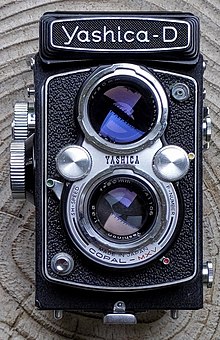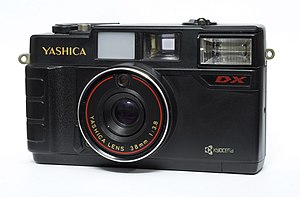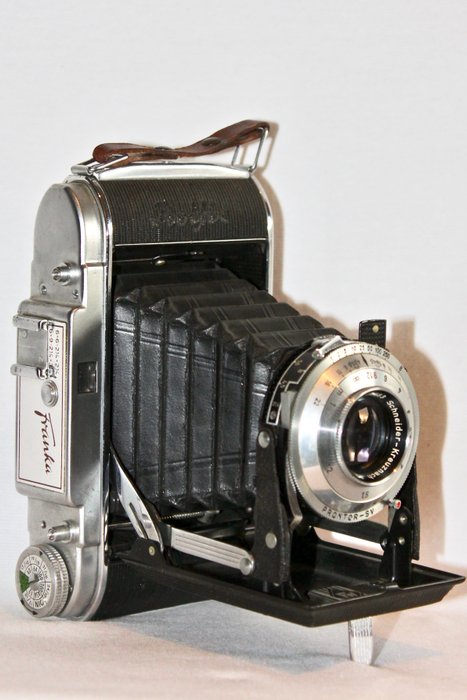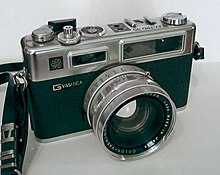كانت Yashica شركة يابانية لتصنيع الكاميرات ، كانت نشطة في الأصل من عام 1949 [1] حتى عام 2005 [2] عندما توقف مالكها آنذاك ، كيوسيرا ، عن الإنتاج.
في عام 2008 ، ظهر اسم Yashica مرة أخرى على الكاميرات التي تنتجها مجموعة MF Jebsen التي تتخذ من هونج كونج مقراً لها. [2] في عام 2015 ، تم نقل حقوق العلامات التجارية إلى Yashica International Company Limited وتم تعيين 100 شركة Enterprises International Group Co. [ بحاجة لمصدر ]
التاريخ
في عام 1957 ، أسس ياشيما شركة Yashica، Inc. ، وهي ذراع فرعية في مدينة نيويورك لإدارة جهود التسويق في الولايات المتحدة. [6] [7] عام 1957 ، شهد أيضًا تقديم سلسلة جديدة من كاميرات TLR ، خط Yashica Mat. [8] بالإضافة إلى كاميرا أفلام سينمائية مقاس 8 مم. خلال العام والنصف التالي ، واصلت ياشيما نموها ، مع وجود 1،982 موظفًا بحلول عام 1958. [9] لاحقًا في عام 1958 ، غيرت ياشيما اسمها إلى شركة ياشيكا المحدودة ، عندما استحوذت على شركة نيكا للكاميرا المحدودة. [10] كان الاستحواذ على نيكا محظوظًا ، حيث ساعدت التصاميم المكتسبة Yashica في توسيع خط إنتاجها إلى كاميرات متغيرة المدى مقاس 35 مم.
تم تقديم Yashica Pentamatic ، وهي كاميرا حديثة ومتطورة أحادية العدسة 35 مم (SLR) مع حامل حربة مملوك ، وحجاب حاجز تلقائي (يتم تقديمه فقط مع عدسة Auto Yashinon 50 مم / 1.8) ، وعدسات قابلة للتبديل ، في عام 1959. كما كان من قبل ، واصلت Yashica مصدر عدساتها من مصنع Tomioka Optical.
حوالي 1959-1960 ، استحوذت Yashica على أصول شركة Zunow Optical Industry Co. المحدودة المفلسة [11] [12] على الرغم من أنها شركة صغيرة ، أصبحت Zunow معروفة بإنتاج محدود لكاميرا SLR متقدمة جدًا مقاس 35 مم ، إلى جانب العديد من جودة عالية ، وكاميرا 35 مم سريعة ، وتصاميم عدسة سينمائية 8 مم (فيلم) ونظام عدسات حربة مملوكة ملكية مماثلة لنظام Yashica Pentamatic. بمساعدة Tomioka Optical Works ، قامت Yashica بتكييف تصميمات عدسات Zunow إلى كاميرات سينمائية 8 مم (فيلم) خاصة بها. [13]

مثل Zunow ، وجدت Yashica صعوبة في الحصول على قبول السوق من خلال تركيب عدسة SLR الخاصة بها ، وأعادت تصميم خط كاميرا SLR في عام 1962 لقبول تركيب عدسة Contax / Praktica M42 . [14] تم تقديم كاميرا SLR الجديدة باسم Penta J.
في ديسمبر 1965 ، قدمت Yashica أول كاميرا 35 مم ناجحة تجاريًا يتم التحكم فيها إلكترونيًا في العالم ، وهي Electro 35 ، وهو نموذج محدد المدى الذي باع في نهاية الأمر 8 ملايين وحدة. [15] واصلت الشركة توسيع أسواقها الدولية ، وفي أغسطس 1968 ، استحوذت Yashica أخيرًا على الشركة المصنعة للعدسات ، Tomioka Optical and Machine Manufacturing Co.، Ltd. (التي أعيدت تسميتها لاحقًا باسم Tomioka Optical Co. Ltd.). [16] بحلول هذا الوقت ، كانت توميوكا واحدة من أكبر الشركات المصنعة للعدسات وأكثرها شهرة في اليابان. استمرت مبيعات كاميرات SLR مقاس 35 مم في النمو بشكل مطرد ، واكتسبت Yashica بسرعة سمعة لكل من خبرة الكاميرا الإلكترونية والبصريات عالية الجودة. كما شهد عام 1968 عام آخر تصميم لكاميرا TLR الرئيسية من Yashica ، وهو Yashica Mat-124 ، وهو نموذج شائع يجمع بين بعض أفضل ميزات كاميرات TLR السابقة من Yashica.
في عام 1968 ، قدمت Yashica كاميرا TL Electro-X 35mm أحادية العدسة العاكسة (SLR) وأنتجتها حتى عام 1974. كان لديها حامل عدسة ملولبة ، جبل عدسة M42 ، لعدساتها القابلة للتبديل. كما أن لديها مقياسًا للتعرض الإلكتروني من خلال العدسة الإلكترونية بالكامل في عدسة الكاميرا باستخدام الأسهم المضيئة (ليست مصابيح LED حقيقية ، والتي تم تقديمها لأول مرة مع Fujica ST801). مصراع Copal Square SE ، مصراع طائرة بؤري متحرك يسير رأسياً مصنوع من قبل شركة Copal Corporation ، مستخدم في الكاميرا ، تم التحكم فيه إلكترونيًا. [17] [18]
في عام 1972 ، قدمت Yashica كاميرا TL Electro 35mm SLR التي كانت مشابهة لكاميرا Pentax Spotmatic التي صنعتها شركة Asahi Optical Company ( Pentax ). يستخدم TL Electro أيضًا عرض مقياس التعرض المضاء بشكل مشابه للشاشة في TL Electro-X ، وكذلك حامل العدسة الملولبة اللولبي M42 لعدساته القابلة للتبديل. [19]
في عام 1973 ، بدأت شركة Yashica في التعاون مع Carl Zeiss أطلقت عليه مشروع Top Secret Project 130 لإنتاج SLR جديد احترافي مقاس 35 مم مع مصراع متحكم به إلكترونيًا يحمل العلامة التجارية Contax ، ويطلق عليه RTS (لـ “Real Time System”). [20] تم إدخال خط هيبة جديد من عدسات Yashica / Contax التي صممها Carl Zeiss للكاميرا ، مع تركيب حربة C / Y شائع يسمح بتبادل العدسة بين جميع طرازات كاميرات Contax و Yashica SLR مقاس 35 مم. [21] تم تعيين F. F. Alexander Porsche Group لإكمال دراسة مريحة للتصميم للكاميرا الجديدة. ظهرت كونتاكس RTS الجديدة في فوتوكينا في عام 1974 ، وحققت نجاحًا تجاريًا ، وسرعان ما قدمت ياشيكا عدة كاميرات SLR جديدة مقاس 35 مم بدءًا من FX-1 (1975) و FX-2 (1976). أيضًا في ذلك العام ، واستجابة لنجاح كونتاكس RTS ، طورت Yashica Yashica FR الراقي باستخدام بعض ميزات RTS ، بما في ذلك إطلاق الغالق الكهرومغناطيسي. [22] كانت FR قادرة على استخدام مجموعة كاملة من عدسات Carl Zeiss T *. في الاختبارات المعاصرة ، تم وصف FR على أنه أكثر صرامة في بعض النواحي من Contax RTS الأكثر تكلفة ، بما في ذلك سد أفضل ضد الغبار والملوثات. [23] ستستمر هذه الممارسة المتمثلة في “إقران” نماذج كونتاكس المتشابهة مع طرازات ياشيكا ذات الأسعار المعقولة الأقل والأقل اكتمالًا ، ولكن لا تزال عالية الجودة للسنوات العشر القادمة. تمت متابعة FR بسرعة في أبريل 1977 من قبل FR-I و FR-II. [24] كانت FR-I عبارة عن SLR مقاس 35 مم توفر المزيد من ميزات RTS ، بما في ذلك غالق إلكتروني مع أوضاع الأولوية اليدوية وفتحة العدسة ، وقد حددت النقطة العالية لعلامة Yashica التجارية في التنافس مع Nikon و Canon و Minolta لـ سوق كاميرات SLR شبه الاحترافية. [25]

في عام 1979 ، قدمت Yashica كاميرا SLR استهلاكية رخيصة الثمن 35 مم ، FX-3 ، مخصصة للمشترين المبتدئين. [26] مثل جميع أجهزة التركيز اليدوي من Yashica ، يتميز جهاز FX-3 الميسور التكلفة بتركيب عدسة C / Y التي تقبل أيضًا عدسات Carl Zeiss T *. تم بيع كاميرا SLR البسيطة خفيفة الوزن ذات التعرض اليدوي بشكل جيد ، ومع المراجعات الطفيفة ، ظلت في الإنتاج حتى عام 2002.
في أكتوبر 1983 ، تم الاستحواذ على شركة Yashica Company Ltd. من قبل شركة الخزف العملاقة Kyocera . في البداية ، أدى الاندماج إلى تغييرات خارجية قليلة. واصل برنامج التركيز البؤري اليدوي (MF) FX-103 ، الذي تم تقديمه في عام 1985 ، تقليد “الاقتران” بين طرازات Yashica SLR المتطورة مع Contax (Contax 159 مم) ، وكان أول Yashica SLR مع فلاش TTL والتعرض المبرمج الكامل قدرات.
بعد عام 1983 ، تم تسويق جميع كاميرات العلامة التجارية Yashica بواسطة Kyocera (سيراميك كيوتو) ، والتي صنعت أيضًا أحدث كاميرات Contax. بحلول عام 1985 ، كانت الشركة تواجه منافسة شديدة في السوق من الشركات المصنعة الأخرى ، وخاصة Minolta ، التي قدمت كاميرا ذات تركيز تلقائي وبأسعار تنافسية ومتقدمة ذات عدسة 35 مم SLR. قدمت Yashica في نهاية المطاف خط الكاميرا ذات التركيز البؤري التلقائي 35 مم SLR الذي كان مبالغًا فيه وسوقًا ضعيفًا مقارنة بمنافستها. ورداً على ذلك ، قامت كيوسيرا تدريجياً بتغيير موقع العلامة التجارية كخط كاميرا للتصوير والتصوير بسعر الميزانية ، ونقل الإنتاج من اليابان إلى هونج كونج ، ووقف إنتاج كاميرات SLR المتطورة.
في عام 2005 ، أوقفت Kyocera الإنتاج في جميع Contax و Yashica وغيرها من الأفلام والكاميرات الرقمية التي تحمل علامة Kyocera. [27] [ فشل التحقق ] [2] في عام 2008 ، قامت كيوسيرا ببيع حقوق العلامة التجارية لـ Yashica إلى MF Jebsen Group التي تتخذ من هونج كونج مقراً لها ، وهي تابعة لشركة JNC Datum Tech International، Limited التابعة لها. منتجات Yashica من شركة JNC Datum Tech International بما في ذلك الكاميرات الرقمية وكاميرات الفيديو الرقمية وإطارات الصور الرقمية ومشغلات DVD المحمولة ومشغلات الصوت الرقمية ومسجلات الصوت الرقمية والمناظير والهواتف المحمولة وبطاقات SD . في مارس 2015 ، تم تعيين 100 شركة مجموعة دولية المحدودة كوكيل Yashica Global وحيد. [ بحاجة لمصدر ]
نماذج الكاميرا
TLRs
| Learn more |


- Pigeonflex (1953)
- Yashimaflex (1953)
- YashicaFlex (1953)
- مولفو ريفليكس (1953)
- Yashicaflex A ، AS I & II (1954)
- ياشيكا سي (1955)
- Yashicaflex Rookie (1956)
- ياشيكا ب (1957)
- ياشيكا LM (1957)
- ياشيكا مات (1957)
- ياشيكا أ (1958) ، د (1958)
- ياشيكا 44 (1958)
- ياشيكا- D (1958)
- ياشيكا 635 (1958)
- ياشيكا أوتو (1959)
- Yashica Mat LM (1959)
- ياشيكا 44LM (1959)
- ياشيكا 44A (1960)
- Yashica Mat EM (1964)
- ياشيكا إي (1964)
- ياشيكا 24 (1965)
- ياشيكا 12 (1967)
- ياشيكا مات 124 (1968)
- ياشيكا مات 124 جم (1970)
- Yashica-Mat 124 B (1975) البرازيل
ربما كان هذا هو الأكثر تطورًا من متغيرات TLR. مثل العديد من الإصدارات السابقة ، كان لديها عداد ضوئي مدمج. يجب أن يتم ضبط سرعة الغالق وفتحة العدسة يدويًا ، ولكنه سمح باستخدام الكاميرا بدون عداد محمول إضافي ، كما سمح هذا النموذج بالتحويل البسيط من 120 لفة فيلم إلى 220 لفة فيلم. ميزة أخرى لهذا النموذج هي مصراع الكاميرا ويتم التحكم في تقدم الفيلم بواسطة مقبض الفيلم المتقدم. كانت النماذج السابقة آلية منفصلة لتصويب الغالق. كان هذا النظام عرضة للتعرض المزدوج غير المقصود.
35 مم المسافة
|
|
35 مم كاميرات SLR


|
|
مدمج 35 مم


|
|
رقمي مضغوط
- ياشيكا Y35 digiFilm
فيلم Super 8mm camera
- Yashica Super YXL-1،1
- Yashica Super YXL-100
- Yashica Super-40k
- Yashica Super-50
- ياشيكا يو ماتيك سوبر 8
- Yashica Nicca Super 30 Electronic
- ياشيكا سوبر 8 10
ـــــــــــــــــــــــــــــــــــــــــــــــــــــــ
Yashica
Yashica was a Japanese manufacturer of cameras, originally active from 1949[1] until 2005[2] when its then-owner, Kyocera, ceased production.
In 2008, the Yashica name reappeared on cameras produced by the Hong Kong-based MF Jebsen Group.[2] In 2015, trademark rights were transferred to Yashica International Company Limited and appointed 100 Enterprises International Group Co. Limited as Yashica Global Sole Agent.[citation needed]
History
The company began in December 1949 in Nagano, Japan, when the Yashima Seiki Company was founded with an initial investment of $566.[1] Its eight employees originally manufactured components for electric clocks.[3] Later, they began making camera components, and by June 1953 had introduced their first complete camera, the Yashimaflex, a twin-lens reflex (TLR) medium-format camera designed for 6×6 cm medium format film. While the Yashimaflex used lenses labeled Tri-Lausar, successive models used Yashikor and Yashinon lenses. All of these lenses were manufactured for Yashica by the Tomioka Optical Works, beginning a relationship that would last for many years.[4] Late in 1953, Yashima Seiki Company became Yashima Optical Industry Company, Ltd.[5]
In 1957, Yashima founded Yashica, Inc., a subsidiary arm in New York City to manage marketing efforts in the United States.[6][7] 1957 also marked the introduction of a popular new TLR camera series, the Yashica Mat line.,[8] as well as an 8mm cine movie camera. During the next year and a half, Yashima continued to grow, with 1,982 employees by 1958.[9] Later in 1958, Yashima changed its name to Yashica Company, Ltd, when it acquired the Nicca Camera Company, Ltd.[10] The Nicca acquisition was fortuitous, as the designs acquired assisted Yashica in expanding its product line into advanced 35mm rangefinder cameras.
The Yashica Pentamatic, an advanced, modern 35mm Single Lens Reflex (SLR) camera with a proprietary bayonet-mount, automatic diaphragm (offered only with the Auto Yashinon 50mm/1.8 lens), and interchangeable lenses, was introduced in 1959. As before, Yashica continued to source its lenses from the Tomioka Optical factory.
Around 1959–1960, Yashica acquired the assets of the bankrupt Zunow Optical Industry Co. Ltd.[11][12] Though a small company, Zunow had become known for limited production of a very advanced 35mm SLR camera, along with several high-quality, fast 35mm camera and 8mm cine (movie) lens designs and a proprietary bayonet-mount lens system similar to that of Yashica Pentamatic. With the assistance of Tomioka Optical Works, Yashica adapted Zunow lens designs into its own 8mm turret cine (movie) cameras.[13]
Like Zunow, Yashica found it difficult to gain market acceptance with its proprietary SLR lens mount, and redesigned its SLR camera line in 1962 to accept the Contax/Praktica M42 lens mount.[14] The new SLR camera was introduced as the Penta J.
In December 1965, Yashica introduced the world’s first commercially successful electronically controlled 35mm camera, the Electro 35, a popular rangefinder model that in various model subvariants eventually sold 8 million units.[15] The company continued to expand its international markets, and in August 1968, Yashica finally acquired its lens manufacturer, the Tomioka Optical and Machine Manufacturing Co., Ltd. (later renamed the Tomioka Optical Co. Ltd.).[16] By this time, Tomioka was one of the largest and most reputable lens manufacturers in Japan. Sales of 35mm SLRs continued to grow steadily, and Yashica was quickly acquiring a reputation for both electronic camera expertise and high-quality optics. 1968 also marked the year of Yashica’s last major TLR camera design, the Yashica Mat-124, a popular model which combined some of the best features of Yashica’s earlier TLR cameras.
In 1968, Yashica introduced the TL Electro-X 35mm single lens reflex (SLR) camera and produced it until 1974. It had a screw thread lens mount, the M42 lens mount, for its interchangeable lenses. It also had an all-electronic through-the-lens exposure meter in the viewfinder using lighted arrows (not true LEDs, which were first introduced with the Fujica ST801). The Copal Square SE shutter, a vertically-travelling metal blade focal plane shutter made by Copal Corporation, used in the camera, was electronically controlled.[17][18]
In 1972, Yashica introduced the TL Electro 35mm SLR camera which was similar to the Pentax Spotmatic camera made by the Asahi Optical Company (Pentax). The TL Electro also used a lighted exposure meter display similar to that in the TL Electro-X, as well as the M42 screw threaded lens mount for its interchangeable lenses.[19]
In 1973, Yashica the company began a collaboration with Carl Zeiss it called Top Secret Project 130 to produce a new, professional 35mm SLR with an electronically controlled shutter bearing the Contax brand, and called the RTS (for “Real Time System”).[20] A new prestige line of Yashica/Contax lenses designed by Carl Zeiss were introduced for the camera, with a common C/Y bayonet mount allowing lens interchange between all 35mm Contax and Yashica SLR camera models.[21] The F. Alexander Porsche Group was hired to complete an ergonomic and styling study of the new camera. The new Contax RTS appeared at photokina in 1974, and became a commercial success.Yashica soon introduced several new 35mm SLR cameras beginning with the FX-1 (1975) and FX-2 (1976). Also in that year, in response to the success of the Contax RTS, Yashica developed the upscale Yashica FR using some of the features of the RTS, including its electromagnetic shutter release.[22] The FR was capable of using the entire range of Carl Zeiss T* lenses. In contemporaneous tests, the FR was described as being tougher in some ways than the more expensive Contax RTS, including better sealing against dust and contaminants.[23] This practice of “pairing” similar Contax models with more affordable, less full-featured, but still high-quality Yashica models would continue for the next ten years. The FR was quickly followed in April 1977 by the FR-I and FR-II.[24] The FR-I was a 35mm SLR offering even more features of the RTS, including an electronic shutter with both manual and aperture priority modes, and marked the high point for the Yashica brand in competing with Nikon, Canon, and Minolta for the semi-professional SLR camera market.[25]
In 1979, Yashica introduced a new inexpensive 35mm consumer SLR, the FX-3, intended for entry-level buyers.[26] Like all Yashica manual-focus bodies, the affordable FX-3 featured a C/Y lens mount that would also accept Carl Zeiss T* lenses. This simple, lightweight manual-exposure SLR camera sold well, and with minor revisions, stayed in production until 2002.
In October 1983, Yashica Company Ltd. was acquired by ceramics giant Kyocera. Initially, the merger resulted in few outward changes. The manual-focus (MF) FX-103 Program, introduced in 1985, continued the “pairing” tradition of high-end Yashica SLR models with Contax (Contax 159 mm), and was the first Yashica SLR with TTL flash and full programmed exposure capabilities.
After 1983, all Yashica brand cameras were marketed by Kyocera (Kyoto Ceramics), which also made newer Contax cameras. By 1985, the company was facing intense market competition from other manufacturers, especially Minolta, which had introduced a competitively priced and advanced autofocus 35mm SLR camera. Yashica eventually introduced its own autofocus 35mm SLR camera line that was overpriced and poorly marketed in comparison to its competition. In response, Kyocera gradually repositioned the brand as a budget-priced point-and-shoot camera line, moving production from Japan to Hong Kong, and discontinued high-end SLR camera production.
In 2005, Kyocera halted production on all Contax, Yashica, and other Kyocera-branded film and digital cameras.[27][failed verification] [2] In 2008, Kyocera sold the trademark rights of Yashica to Hong Kong-based MF Jebsen Group, and is under its subsidiary JNC Datum Tech International, Limited. Yashica’s products from JNC Datum Tech International including digital cameras, digital camcoders, digital photo frames, portable DVD players, digital audio players, digital voice recorders, binoculars, mobile phones and SD cards. In March 2015, 100 Enterprises International Group Co. Ltd. has been appointed as Yashica Global Sole Agent.[citation needed]
Camera models
TLRs
|
This section does not cite any sources. (July 2019) (Learn how and when to remove this template message)
|
- Pigeonflex (1953)
- Yashimaflex (1953)
- YashicaFlex (1953)
- MolfoReflex (1953)
- Yashicaflex A, AS I & II (1954)
- Yashica C (1955)
- Yashicaflex Rookie (1956)
- Yashica B (1957)
- Yashica LM (1957)
- Yashica-Mat (1957)
- Yashica A (1958), D (1958)
- Yashica 44 (1958)
- Yashica-D (1958)
- Yashica 635 (1958)
- Yashica Auto (1959)
- Yashica Mat LM (1959)
- Yashica 44LM (1959)
- Yashica 44A (1960)
- Yashica Mat EM (1964)
- Yashica E (1964)
- Yashica 24 (1965)
- Yashica 12 (1967)
- Yashica-Mat 124 (1968)
- Yashica-Mat 124 G (1970)
- Yashica-Mat 124 B (1975) Brazil
This was perhaps the most evolved of the TLR variants. Like several of the earlier versions it did feature a built in light meter. Settings to the shutter speed and aperture had to be made manually but it did allow the camera to be used without an additional handheld meter.This model also allowed the simple conversion from 120 roll film to 220 roll film. Another advantage to this model was the shutter and film advance were controlled by the film advance handle. Earlier models had a separate mechanism for cocking the shutter. This system was prone to inadvertent double exposures.
35mm rangefinder
|
|
35mm SLR cameras
|
|
Compact 35mm
|
|
Compact Digital
- Yashica Y35 digiFilm
Super 8mm movie camera
- Yashica Super YXL-1,1
- Yashica Super YXL-100
- Yashica Super-40k
- Yashica Super-50
- Yashica U-Matic Super 8
- Yashica Nicca Super 30 Electronic
- Yashica Super 8 10
Sources
- Reynolds, Clyde (1978). The Contax RTS and Yashica SLR Bayonet and Screw Mount Book. London: Focal Press. ISBN 0-240-50978-1.
- Heiberg, Milton (1979). The Yashica Guide, A Modern Camera Guide Series Book. New York: Amphoto. ISBN 0-8174-2151-3.













